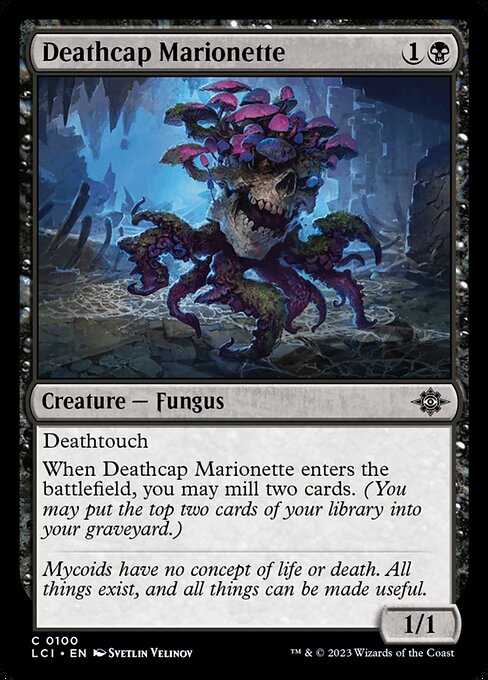
Image courtesy of Scryfall.com
Iconic Visual Language: How the Deathcap Marionette Art Captivates Fans
In the vast, fungus-haunted corners of Magic: The Gathering, certain visuals endure because they marry mood, mystery, and a touch of menace. Deathcap Marionette stands tall in that cadre. Painted by Svetlin Velinov for The Lost Caverns of Ixalan, this common black creature does more than fill a creature slot—it tells a story with every inch of its design. The art leans into a bioluminescent, otherworldly darkness, where the familiar beauty of mushrooms folds into a creeping dread. It’s the sort of image that makes you pause, zoom in, and replay the moment in your head as you consider milling your way toward a win. 🧙🔥💎
Color, Contrast, and Creature Identity
Deathcap Marionette’s mana cost is modest—{1}{B}—but the art amplifies the color identity in stories you tell at the table. Black mana in MTG has long been about boundaries, risk, and the unseen. Velinov’s portrayal layers those themes: a 1/1 Fungus with deathtouch feels like a small, cunning blade wrapped in shadow, the sort of creature that doesn’t announce itself with a roar, but with quiet threat. The art’s tonal range—deep blacks contrasted with muted, organic browns and eerie greens—echoes the card’s mechanical flavor: a tiny, terrifying puppet whose arrival nudges both players toward a graveyard-centered turnsequence. The image is as much about atmosphere as it is about stats, and that atmosphere is what keeps it memorable long after the game ends. ⚔️
Mechanics Portrayed in Visual Form
Beyond the silhouette, the card’s enter-the-battlefield ability—“When this creature enters, you may mill two cards”—is suggested by the marionette motif. The visuals imply a puppet master’s patient pull, a subtle cue that this fungus isn’t merely a creature but a planning tool that nudges the game toward the graveyard. The deathtouch keyword is given a tactile interpretation: a tiny, mercurial danger that lurks in the dark, ready to convert a trade into a lethal moment. The art and text align to communicate a philosophy of low-impact on the board that compounds into gnarly late-game possibilities. 🧩
Lore, Flavor, and the Ixalan Echo
The flavor text—“Mycoids have no concept of life or death. All things exist, and all things can be made useful.”—feels squarely at home in Ixalan’s subterranean mythos. The Lost Caverns of Ixalan leans into a wild, cavernous anthropology where fungal life forms are both cunning and indispensable. Deathcap Marionette embodies that paradox: it’s small in scale, yet potent in effect, a creature that makes you contemplate the cycle of life, death, and library management. The art mirrors this tension, suggesting a world where growth and decay are two sides of the same cap. 🎨
Why This Image Stands Out Among Common Cards
- Memorable silhouette: The puppet-like posture and cap shape create an instantly recognizable silhouette that scales well to both border and foil treatments.
- Textural depth: Velinov’s use of micro-details—gills, spores, and a faint web of strings—adds depth that rewards closer inspection, even at common rarity.
- Narrative potential: The image invites storytelling—what strings pull this creature, what two cards have you milled, what happens after the reveal? That narrative spark makes the art feel iconic rather than merely decorative.
- Artistic fidelity to the set’s mood: As part of The Lost Caverns of Ixalan, it shares a cavernous, fungal aesthetic with other pieces in the cycle, creating a cohesive visual microcosm that fans gravitate toward. 🎲
From Artwork to Playability and Collectibility
Though Deathcap Marionette is a common card, its impact stretches beyond a humble board presence. In Commander and other black-focused archetypes, milling can be a legitimate angle, turning the “you mill two” risk into a strategic asset when paired with graveyard-based strategies. The art’s enduring appeal—coupled with Svetlin Velinov’s distinctive brushwork—drives demand in collectors’ circles, even when the card’s raw numbers aren’t earth-shattering. The piece also highlights an important reality: iconic card art often outlives its mechanical power, becoming a gateway for nostalgia, conversation, and reprints that never quite recapture the same magic. 💎
For purists who savor the full art experience, the foil treatment and nonfoil versions alike offer a tactile reminder of the image’s enduring charm. The Lost Caverns of Ixalan as a set leans into a lush, exploratory vibe, and this card is a tactile postcard from that subterranean world. The art then becomes a talking point at the kitchen table—an icebreaker for newer players and a reminder of why MTG’s art direction remains a cornerstone of the hobby. ⚔️
How Fans Can Celebrate the Aesthetic at Home
If you’re chasing a way to bring MTG aesthetics into daily life, the card’s vibe translates nicely into display-worthy pieces: art prints, token art, or even a themed item like a phone case that carries the same dark, fungal energy. The provided product link offers a stylish way to merge everyday gear with MTG fandom—without sacrificing modern-day practicality. The synergy between card art and real-world accessories is a reminder that the multiverse isn’t confined to battlefields alone; it travels with you, in small, delightful ways. 🧙♀️💼
Pro tip for players and collectors alike: keep an eye on the Lost Caverns of Ixalan print runs, especially foils and alternate arts released in various promos. While this particular Deathcap Marionette sits at common, the broader art direction of the set is an excellent barometer for how Wizards of the Coast envisions fungal, shadowy temptations across the black spectrum. If you enjoy the aesthetic, you’ll likely find other pieces in the same vein that resurface with new promos and reprints. 🎨